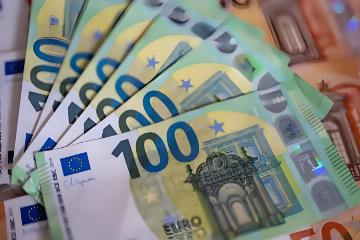The Euro is Set to Fall Below Parity
Advertisements
In the world of finance, market predictions are often met with keen interest and scrutiny, especially when they are made by influential institutions like Goldman SachsRecently, the investment giant made headlines by revising its forecasts for the U.Sdollar, anticipating a rise of approximately 5% in the coming yearThis marked the second time in just two months that Goldman Sachs adjusted its outlook on the dollar, prompting investors to reconsider their strategies in a volatile and uncertain market.
The significance of this prediction cannot be underestimatedThe announcement has stirred discussions among foreign exchange traders and economists alike, highlighting the shifting dynamics in the global currency marketsWith the euro projected to lose ground against the dollar, reaching a value of 0.97, this potential downturn echoes the last instance when the euro fell below parity back in 2022. The ramifications of such a shift could ripple through the global economy, affecting trade balances, inflation rates, and consumer purchasing power.
Goldman Sachs's view on the dollar's trajectory is rooted in several robust economic indicators
Advertisements
The firm suggests that a strong U.Seconomy, characterized by steady growth and healthy corporate profits, is a key driver behind the anticipated increase in dollar valueThe influx of international capital seeking better returns in U.Smarkets naturally creates a higher demand for the dollar, leading to its appreciationIt's comparable to a thriving restaurant that garners attention; as more patrons arrive, the perceived value of its offerings increases.
Moreover, U.Stariff policies are also supporting the dollar's strengthBy potentially limiting monetary easing, these tariffs enhance the dollar's comparative attractiveness on the international stageThis protectionist approach essentially fortifies the U.Seconomy, creating a stronger position for the dollar amidst global currency competition.
In addition to economic policies, the job market plays a vital role in supporting the dollar's value
Advertisements
Recent employment reports indicate an uptick in job growth and a decline in the unemployment rate, signaling a resilient U.SeconomyAs consumers gain more purchasing power, economic activity could accelerate, further bolstering the dollarThis cycle of growth tends to create a positive feedback loop, where increased consumer confidence leads to higher spending, resulting in a stronger currency.
As the dollar appears set for a more robust performance, the euro faces a precarious situationThe specter of the euro potentially falling below parity again is particularly concerning for the Eurozone, especially in light of the economic challenges it faced in 2022. Factors such as sluggish growth, energy price surges, and escalating production costs have continued to undermine the euro's stabilityPast experiences have shown that when the euro depreciates, it can have severe consequences on imports, leading to inflating costs for consumers while complicating the debt situation for nations heavily reliant on euro-denominated obligations.
Goldman Sachs's forecast carries substantial weight in the financial community, and their prediction of the euro's decline adds urgency to the discussions surrounding Eurozone economic policies
Advertisements
If the euro were indeed to decline to 0.97, it could deepen issues such as rising import costs and increased living expenses, effectively stifling consumer spending and economic growth in the region.
Economic stagnation in major European economies, including Germany and France, compounds these challengesBusiness investment has been reluctant, and a lack of consumer confidence further restrains growth potentialAdditionally, the Eurozone's reliance on energy imports makes it vulnerable to fluctuations in energy prices, which can add pressure to an already fragile economic landscapeThis ongoing energy crisis has forced businesses to rethink operational costs and profitability, intensifying the challenges they face.
Facing these daunting economic realities, the European Central Bank (ECB) finds itself in a bindOn one hand, it may be necessary to adopt looser monetary policies to stimulate growth, yet doing so risks escalating inflation rates
- Rapid Expansion of Greece's PV Industry
- Waller Hints at Rate Cut: Gold Market in Focus
- Did Tesla’s Price Cuts Hurt Revenue and Boost BYD?
- AI's Rise Fuels Expanding Market Opportunities
- U.S. Mortgage Rates Surpass 7%
Conversely, tightening policies to combat inflation could inadvertently squeeze the economy further, stymieing potential recoveryFor the euro, the outlook remains bleak without significant adjustments in policy and strategy.
The implications of a strengthening U.Sdollar and a weakening euro span beyond the immediate economic landscapes of the respective regionsThe interplay between these two currencies can disrupt global trade patterns and fundamentally alter how nations approach their economic strategiesFor countries importing goods priced in dollars, the rising value of the dollar signifies increased costs, potentially leading to inflationary pressures that affect consumers' daily livesIt mirrors a situation where a previously affordable product becomes a financial burden.
On the flip side, nations exporting goods to the U.Smay find their products more competitive in the American market, leading to increased exports

However, this scenario creates a dichotomy for European exporters, who may benefit from favorable pricing while simultaneously facing soaring costs for imported raw materialsThe persistent flux of currency valuations puts many businesses in a precarious position, requiring strategic adaptations to navigate the evolving market landscape.
As these shifts unfold, individual investors and the average consumer must also engage with how these changes will affect their financial choicesFor those holding foreign currency assets, particularly euros, a declining value poses the risk of decreased asset worthConversely, investments in dollar-denominated assets may present new opportunities, though they are not without riskAs the landscape evolves, careful consideration of shifting economic indicators and political dynamics becomes critical to making informed financial decisions.
In conclusion, the predictions made by Goldman Sachs not only reshape the immediate landscape of currency exchange but also prompt a wider reflection on global economic relationships and individual financial strategies